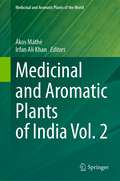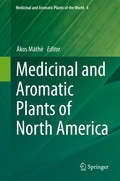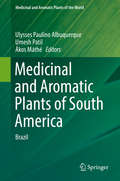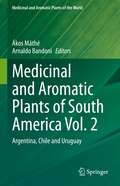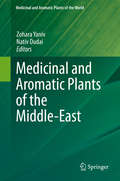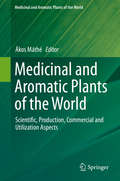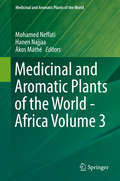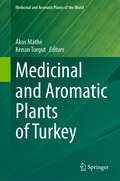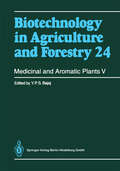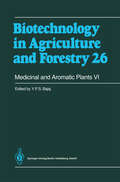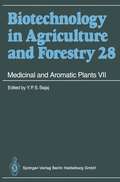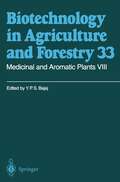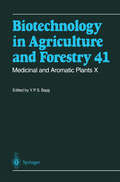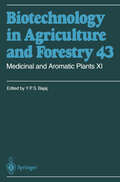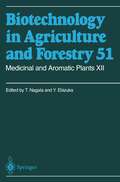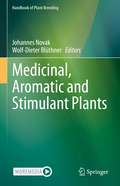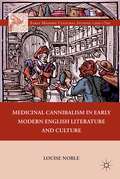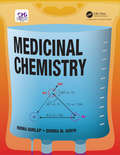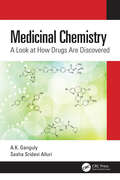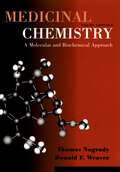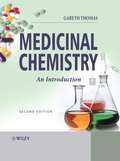- Table View
- List View
Medicinal and Aromatic Plants of India Vol. 2 (Medicinal and Aromatic Plants of the World #9)
by Ákos Máthé Irfan Ali KhanThis book is the 9th volume in the series Medicinal and Aromatic Plants of the World. India being one of the countries with the longest and richest past/present/future of Medicinal and Aromatic Plant (MAP) production and utilization has accumulated more than sufficient knowledge to fill two volumes. This is shown by the vivid interest of Indian colleagues to contribute. Similar to the previous volumes, this one deals with the various important aspects (from botanical through phytochemical to pharmacological) of MAPs', famous or simply known of India. Scientific and technological achievements will be equally presented.In addition to the first volume, India V1, this volume is aimed to look carefully at our present knowledge of this vas interdisciplinary domain with an Indian focus. In the era of global climate change and pandemics, building on the huge Indian traditions, this book is expected to make an important contribution to the better knowledge and understanding of MAPs.
Medicinal and Aromatic Plants of North America (Medicinal and Aromatic Plants of the World #6)
by Ákos MáthéThis volume is aimed at offering an insight into the present knowledge of the vast domain of Medicinal and Aromatic Plants with a focus on North America. In this era of global climate change the volume is meant to provide an important contribution to a better understanding of the diverse world of Medicinal and Aromatic Plant research, production and utilization.
Medicinal and Aromatic Plants of South America: Brazil (Medicinal and Aromatic Plants of the World #5)
by Ulysses Paulino Albuquerque Umesh Patil Ákos MáthéThis volume in the series deals with the major Medicinal and Aromatic Plants (MAPs) of South America, providing information on major aspects of this specific group of plants on that continent (botany, traditional usage, chemistry, production/collection practices, trade and utilization). Brazil, in particular, offers an immense amount of biodiversity, including plants with great pharmacological interest and ethno-medicinal importance. Contributions are from internationally recognized professionals, specialists of the Medicinal and Aromatic Plant domain and have been invited mostly from the members of the International Society for Horticultural Science and International Council for Medicinal and Aromatic Plants.
Medicinal and Aromatic Plants of South America Vol. 2: Argentina, Chile and Uruguay (Medicinal and Aromatic Plants of the World #7)
by Ákos Máthé Arnaldo BandoniThis volume, as the seventh of the series Medicinal and Aromatic Plants of the World, deals with the medicinal and aromatic plant (MAPs) treasures of the so-called Southern Cone, the three southernmost countries (Argentina, Chile and Uruguay) of South America. Similarly to the previous volumes of the series, the main focus is to collect and provide information on major aspects of botany, traditional usage, chemistry, production / collection practices, trade and utilization of this specific group of plants. The contributors, who are recognized professionals and specialist of the domain, have collected and present state of the art information on 41 species. Most of these are not only of interest from the scientific point of view, but hold also a potential for the prospective utilization of the decreasing, occasionally overexploited / endangered medicinal plant resources of this huge continent. The book is expected to serve as a source of information also on some less known or less studied species. As such the volume is expected to support future research and public health professionals.
Medicinal and Aromatic Plants of the Middle-East (Medicinal and Aromatic Plants of the World #2)
by Zohara Yaniv Nativ DudaiThe current volume, "Medicinal and Aromatic Plants of the Middle-East" brings together chapters on selected, unique medicinal plants of this region, known to man since biblical times. Written by leading researchers and scientists, this volume covers both domesticated crops and wild plants with great potential for cultivation. Some of these plants are well-known medicinally, such as opium poppy and khat, while others such as apharsemon and citron have both ritual and medicinal uses. All have specific and valuable uses in modern society. As such, it is an important contribution to the growing field of medicinal and aromatic plants. This volume is intended to bring the latest research to the attention of the broad range of botanists, ethnopharmacists, biochemists, plant and animal physiologists and others who will benefit from the information gathered therein. Plants know no political boundaries, and bringing specific folklore to general medical awareness can only be for the benefit of all.
Medicinal and Aromatic Plants of the World: Scientific, Production, Commercial and Utilization Aspects (Medicinal and Aromatic Plants of the World #1)
by Ákos MáthéMedicinal and aromatic plants (MAPs) have accompanied mankind from its very early beginnings. Their utilization has co-evolved with homo sapiens itself bringing about a profound increase in our scientific knowledge of these species enabling them to be used in many facets of our life (e.g. pharmaceutical products, feed- and food additives, cosmetics, etc.). Remarkably, despite the new renaissance of MAPs usage, ca. 80 % of the world’s population is relying on natural substances of plant origin, with most of these botanicals sourced from the wild state. This first volume and ultimately the series, provides readers with a wealth of information on medicinal and aromatic plants.
Medicinal and Aromatic Plants of the World - Africa Volume 3 (Medicinal and Aromatic Plants of the World #3)
by Mohamed Neffati Hanen Najjaa Ákos MáthéThis volume in the series is devoted to Africa, a continent that possesses a vast treasure of medicinal plants and has produced some exclusive materials for the world market. This volume is expected to strengthen the medicinal plant sector in African countries by making comprehensive information on medicinal and aromatic plants available to policy-makers and entrepreneurs. It can be used to frame effective policies and create an environment conducive to the growth of the plant-based medicine industry, bringing economic benefit to African nations. It will help health organizations to improve the health of their people by using their own resources and a less expensive system of medicine, which is accepted by African society. It could also lead scientific communities to increase R&D activities in the field.
Medicinal and Aromatic Plants of Turkey (Medicinal and Aromatic Plants of the World #10)
by Ákos Máthé Kenan TurgutThis is meant to be the 10th volume of the series Medicinal and Aromatic Plants of the World. Similarly, to the previous volumes, the work will deal -in a monographic form- with MAPs characteristic/famous or simply known of Turkey, a large country that is connecting Europe with Asia. Turkey has extremely rich and varied topographic/ecologic conditions. As a result, the flora of Turkey abounds in an astonishingly great number of endemic MAP species. Traditional, present and possible prospective uses will be discussed. Scientific and technological achievements will be equally presented. Briefly, the volume is aimed to look carefully at our present knowledge of this vast interdisciplinary domain of medicinal and aromatic plants with a focus on Turkey. In the era of global climate change and Covid-pandemics, building on the huge Turkish traditions, the proposed volume of the series is expected to make an important contribution to the better knowledge and understanding of the MAP wealth of the World.
Medicinal and Aromatic Plants VII (Biotechnology in Agriculture and Forestry #28)
by Professor Dr. BajajMedicinal and Aromatic Plants VIII (Biotechnology in Agriculture and Forestry #33)
by Professor Dr. BajajMedicinal and Aromatic Plants XII (Biotechnology in Agriculture and Forestry #51)
by Toshiyuki Nagata Yutaka EbizukaMedicinal, Aromatic and Stimulant Plants (Handbook of Plant Breeding #12)
by Johannes Novak Wolf-Dieter BlüthnerThe agricultural sector of medicinal (including plant stimulants) and aromatic plants is characterized by an enormous number and diversity of species. Only a few of them can be considered cultivated crops in which significant breeding efforts are made. For most species, however, breeding is performed in short-term projects only. Therefore, basic knowledge about these species is still fragmentary. Our intention is to compile and organize the available information on the most commonly utilized plant species into one publication, thereby providing a standardized resource for the researchers and the grower community. This book therefore provides reference source materials for a wide variety of plant species used for human consumption due to their flavor, medicinal or recreational properties. It is divided into a section of general topics on genetic resources, breeding adaptation of analytic methods and a compilation of basic data for DNA content, chromosome number and mating system followed by a section of 20 monographs on a species or species groups.
Medicinal Cannibalism in Early Modern English Literature and Culture (Early Modern Cultural Studies 1500–1700)
by L. NobleThe human body, traded, fragmented and ingested is at the centre of Medicinal Cannibalism in Early Modern English Literature and Culture , which explores the connections between early modern literary representations of the eaten body and the medical consumption of corpses.
Medicinal Chemistry
by Norma K Dunlap Donna M HurynMedicinal Chemistry begins with the history of the field, starting from the serendipitous use of plant preparations to current practice of design- and target-based screening methods. Written from the perspective of practicing medicinal chemists, the text covers key drug discovery activities such as pharmacokinetics and patenting, as well as the classes and structures of drug targets (receptors, enzymes, nucleic acids, and protein-protein and lipid interactions) with numerous examples of drugs acting at each type. Selected therapeutic areas include drugs to treat cancer, infectious diseases, and central nervous system disorders. Throughout the book, historical and current examples illustrate the progress to market and case studies explore the applications of concepts discussed in the text. Each chapter features a Journal Club, as well as review and application questions to enhance and test comprehension. This textbook is ideal for upper-level undergraduates and graduate students taking a one-semester survey course on medicinal chemistry and/or drug discovery, as well as scientists entering the pharmaceutical industry.
Medicinal Chemistry
by Norma K Dunlap Donna M HurynMedicinal Chemistry begins with the history of the field, starting from the serendipitous use of plant preparations to current practice of design- and target-based screening methods. Written from the perspective of practicing medicinal chemists, the text covers key drug discovery activities such as pharmacokinetics and patenting, as well as the classes and structures of drug targets (receptors, enzymes, nucleic acids, and protein-protein and lipid interactions) with numerous examples of drugs acting at each type. Selected therapeutic areas include drugs to treat cancer, infectious diseases, and central nervous system disorders. Throughout the book, historical and current examples illustrate the progress to market and case studies explore the applications of concepts discussed in the text. Each chapter features a Journal Club, as well as review and application questions to enhance and test comprehension. This textbook is ideal for upper-level undergraduates and graduate students taking a one-semester survey course on medicinal chemistry and/or drug discovery, as well as scientists entering the pharmaceutical industry.
Medicinal Chemistry: A Look at How Drugs Are Discovered
by A.K. Ganguly Sesha Sridevi AlluriMedicinal Chemistry: A Look at How Drugs Are Discovered is written for those who are interested in learning how drugs are discovered. Compared to other books on the market, this text takes a different approach by presenting the subject on chemical reaction mechanism terms, which ideally makes the subject matter more interesting and easier to comprehend. The authors describe the drug discovery process, from advancing an initial lead to the approval process, and include drug discovery sources. Additional features: Explains medicinal chemistry on chemical mechanism terms, allowing for a more interesting and easier to comprehend text Includes valuable insights toward the various pathways taken at pharmaceutical industries in drug discoveries Improved by including questions raised and suggestions made from students in the authors’ medicinal chemistry classes This book will benefit both upper level undergraduates and graduates studying in the fields of medicinal chemistry and drug discovery, as well as scientists working in the pharmaceutical industry.
Medicinal Chemistry: A Look at How Drugs Are Discovered
by A.K. Ganguly Sesha Sridevi AlluriMedicinal Chemistry: A Look at How Drugs Are Discovered is written for those who are interested in learning how drugs are discovered. Compared to other books on the market, this text takes a different approach by presenting the subject on chemical reaction mechanism terms, which ideally makes the subject matter more interesting and easier to comprehend. The authors describe the drug discovery process, from advancing an initial lead to the approval process, and include drug discovery sources. Additional features: Explains medicinal chemistry on chemical mechanism terms, allowing for a more interesting and easier to comprehend text Includes valuable insights toward the various pathways taken at pharmaceutical industries in drug discoveries Improved by including questions raised and suggestions made from students in the authors’ medicinal chemistry classes This book will benefit both upper level undergraduates and graduates studying in the fields of medicinal chemistry and drug discovery, as well as scientists working in the pharmaceutical industry.
Medicinal Chemistry: A Molecular and Biochemical Approach
by Thomas Nogrady Donald F. WeaverFully updated and rewritten by a basic scientist who is also a practicing physician, the third edition of this popular textbook remains comprehensive, authoritative and readable. Taking a receptor-based, target-centered approach, it presents the concepts central to the study of drug action in a logical, mechanistic way grounded on molecular and principles. Students of pharmacy, chemistry and pharmacology, as well as researchers interested in a better understanding of drug design, will find this book an invaluable resource. Starting with an overview of basic principles, Medicinal Chemistry examines the properties of drug molecules, the characteristics of drug receptors, and the nature of drug-receptor interactions. Then it systematically examines the various families of receptors involved in human disease and drug design. The first three classes of receptors are related to endogenous molecules: neurotransmitters, hormones and immunomodulators. Next, receptors associated with cellular organelles (mitochondria, cell nucleus), endogenous macromolecules (membrane proteins, cytoplasmic enzymes) and pathogens (viruses, bacteria) are examined. Through this evaluation of receptors, all the main types of human disease and all major categories of drugs are considered. There have been many changes in the third edition, including a new chapter on the immune system. Because of their increasingly prominent role in drug discovery, molecular modeling techniques, high throughput screening, neuropharmacology and genetics/genomics are given much more attention. The chapter on hormonal therapies has been thoroughly updated and re-organized. Emerging enzyme targets in drug design (e.g. kinases, caspases) are discussed, and recent information on voltage-gated and ligand-gated ion channels has been incorporated. The sections on antihypertensive, antiviral, antibacterial, anti-inflammatory, antiarrhythmic, and anticancer drugs, as well as treatments for hyperlipidemia and peptic ulcer, have been substantially expanded. One new feature will enhance the book's appeal to all readers: clinical-molecular interface sections that facilitate understanding of the treatment of human disease at a molecular level.
Medicinal Chemistry: An Introduction
by Gareth ThomasMedicinal Chemistry: An Introduction, Second Edition provides a comprehensive, balanced introduction to this evolving and multidisciplinary area of research. Building on the success of the First Edition, this edition has been completely revised and updated to include the latest developments in the field. Written in an accessible style, Medicinal Chemistry: An Introduction, Second Edition carefully explains fundamental principles, assuming little in the way of prior knowledge. The book focuses on the chemical principles used for drug discovery and design covering physiology and biology where relevant. It opens with a broad overview of the subject with subsequent chapters examining topics in greater depth. From the reviews of the First Edition: "It contains a wealth of information in a compact form" ANGEWANDTE CHEMIE, INTERNATIONAL EDITION "Medicinal Chemistry is certainly a text I would chose to teach from for undergraduates. It fills a unique niche in the market place." PHYSICAL SCIENCES AND EDUCATIONAL REVIEWS
Medicinal Chemistry: An Introduction
by Gareth ThomasMedicinal Chemistry: An Introduction, Second Edition provides a comprehensive, balanced introduction to this evolving and multidisciplinary area of research. Building on the success of the First Edition, this edition has been completely revised and updated to include the latest developments in the field. Written in an accessible style, Medicinal Chemistry: An Introduction, Second Edition carefully explains fundamental principles, assuming little in the way of prior knowledge. The book focuses on the chemical principles used for drug discovery and design covering physiology and biology where relevant. It opens with a broad overview of the subject with subsequent chapters examining topics in greater depth. From the reviews of the First Edition: "It contains a wealth of information in a compact form" ANGEWANDTE CHEMIE, INTERNATIONAL EDITION "Medicinal Chemistry is certainly a text I would chose to teach from for undergraduates. It fills a unique niche in the market place." PHYSICAL SCIENCES AND EDUCATIONAL REVIEWS
Medicinal Chemistry: A Molecular and Biochemical Approach
by Donald F. Weaver Thomas NogradyFully updated and rewritten by a basic scientist who is also a practicing physician, the third edition of this popular textbook remains comprehensive, authoritative and readable. Taking a receptor-based, target-centered approach, it presents the concepts central to the study of drug action in a logical, mechanistic way grounded on molecular and principles. Students of pharmacy, chemistry and pharmacology, as well as researchers interested in a better understanding of drug design, will find this book an invaluable resource. Starting with an overview of basic principles, Medicinal Chemistry examines the properties of drug molecules, the characteristics of drug receptors, and the nature of drug-receptor interactions. Then it systematically examines the various families of receptors involved in human disease and drug design. The first three classes of receptors are related to endogenous molecules: neurotransmitters, hormones and immunomodulators. Next, receptors associated with cellular organelles (mitochondria, cell nucleus), endogenous macromolecules (membrane proteins, cytoplasmic enzymes) and pathogens (viruses, bacteria) are examined. Through this evaluation of receptors, all the main types of human disease and all major categories of drugs are considered. There have been many changes in the third edition, including a new chapter on the immune system. Because of their increasingly prominent role in drug discovery, molecular modeling techniques, high throughput screening, neuropharmacology and genetics/genomics are given much more attention. The chapter on hormonal therapies has been thoroughly updated and re-organized. Emerging enzyme targets in drug design (e.g. kinases, caspases) are discussed, and recent information on voltage-gated and ligand-gated ion channels has been incorporated. The sections on antihypertensive, antiviral, antibacterial, anti-inflammatory, antiarrhythmic, and anticancer drugs, as well as treatments for hyperlipidemia and peptic ulcer, have been substantially expanded. One new feature will enhance the book's appeal to all readers: clinical-molecular interface sections that facilitate understanding of the treatment of human disease at a molecular level.
